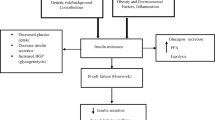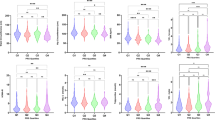Abstract
Aims and objective: It is widely accepted that the genetic make-up of the subject plays a pivotal role in the development of insulin resistance and β cell failure. The objective of this study was to examine whether the same or distinct genetic backgrounds contribute to the development of insulin resistance and β cell failure. Methods: We examined insulin sensitivity and β cell function in lean normal glucose tolerance subjects from 3 multigeneration Arab families. Families 1 and 2 had strong history of Type 2 diabetes (T2DM), while no member of family 3 had T2DM. Results: Subjects in family 1 manifested increased basal plasma free fatty acid (FFA) concentration and impaired suppression of plasma FFA during the OGTT compared to subjects in family 3. Subjects in family 2 had comparable fasting plasma FFA and suppression of plasma FFA during the OGTT to family 3. Both the absolute plasma glucose concentrations, and incremental area under the plasma glucose curve (ΔG0–120) during the OGTT were comparable in subjects of families 1 and 2, and were decreased in subjects of family 3. Whole body and muscle insulin sensitivity were comparable in subjects from families 2 and 3, and both were significantly decreased in subjects of family 1. Beta cell function was comparable in subjects of families 1 and 3 and was significantly decreased in subjects of family 2. Conclusion: These results demonstrate that distinct genetic background contributes to the development of insulin resistance and β cell dysfunction in Arab individuals.
Similar content being viewed by others
References
DeFronzo RA. Pathogenesis of type 2 diabetes mellitus. Med Clin North Am 2004, 88: 787–835.
Abdul-Ghani MA, DeFronzo RA. Pathophysiology of prediabetes. Curr Diab Rep 2009, 9: 193–9.
Abdul-Ghani MA, Tripathy D, DeFronzo RA. Contribution of beta cell dysfunction and insulin resistance to the pathogenesis of impaired glucose tolerance and impaired fasting glucose. Diabetes Care 2006, 29: 1130–9.
Abdul-Ghani MA, Jenkinson C, Richardson D, DeFronzo RA. Insulin secretion and insulin action in subjects with impaired fasting glucose and impaired glucose tolerance: results from the Veterans Administration Genetic Epidemiology Study (VEGAS). Diabetes 2006, 55: 1430–5.
Groop LC, Bonadonna RC, Del Prato S, et al. Glucose and free fatty acid metabolism in non-insulin-dependent diabetes mellitus. Evidence for multiple sites of insulin resistance. J Clin Invest 1989, 84: 205–13.
Petersen KF, Dufour S, Befroy D, et al. Impaired mitochondrial activity in the insulin-resistant offspring of patients with type 2 diabetes. N Engl J Med 2004, 350: 664–71.
Kashyap SR, Belfort R, Berria R, et al. Discordant effects of a chronic physiological increase in plasma FFA on insulin signaling in healthy subjects with or without a family history of type 2 diabetes. Am J Physiol Endocrinol Metab 2004, 287: E537–46.
Pimenta W, Korytkowski M, Mitrakou A, et al. Pancreatic beta-cell dysfunction as the primary genetic lesion in NIDDM. Evidence from studies in normal glucose-tolerant individuals with a first-degree NIDDM relative. JAMA 1995, 273: 1855–61.
Doria A, Patti ME, Kahn CR. The emerging genetic architecture of type 2 diabetes. Cell Metab 2008, 8: 186–200.
Abdul-Ghani MA, Matsuda M, Balas B, DeFronzo RA. Muscle and liver insulin resistance indexes derived from the oral glucose tolerance test. Diabetes Care 2007, 30: 89–94.
Abdul-Ghani MA, Molina-Carrion M, Jani R, Jenkinson C, Defronzo RA. Adipocytes in subjects with impaired fasting glucose and impaired glucose tolerance are resistant to the anti-lipolytic effect of insulin. Acta Diabetol 2008, 45: 147–50.
Abdul-Ghani MA, DeFronzo RA. Pathogenesis of insulin resistance in skeletal muscle. J Biomed Biotechnol 2010, doi:10.1155/2010/476279
Ferrannini E, Bjorkman O, Reichard GA jr, et al. The disposal of an oral glucose load in healthy subjects. A quantitative study. Diabetes 1985, 34: 580–8.
Author information
Authors and Affiliations
Corresponding author
Rights and permissions
About this article
Cite this article
Shalata, A., Jazmawi, W., Aslan, O. et al. Early metabolic defects in Arab subjects with strong family history of Type 2 diabetes. J Endocrinol Invest 36, 417–421 (2013). https://doi.org/10.3275/8762
Accepted:
Published:
Issue Date:
DOI: https://doi.org/10.3275/8762




